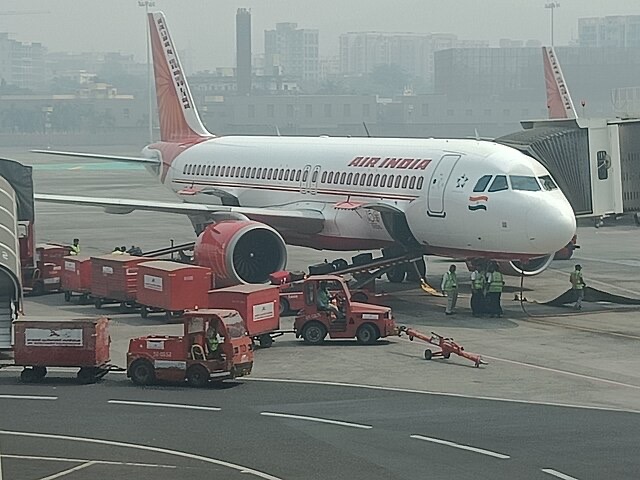An Air India aircraft was grounded at Delhi’s Indira Gandhi International Airport on Tuesday after fire broke out in its auxiliary power unit whilst passengers were disembarking from a flight from Hong Kong.
The incident involving flight AI315, an Airbus A321, occurred at 12.31pm local time after the aircraft had landed safely and parked at the gate. All 170 passengers and crew evacuated without injury, though the aircraft sustained damage and has been taken out of service for investigation.
“Flight AI 315, operating from Hong Kong to Delhi on 22 July 2025, experienced an auxiliary power unit (APU) fire shortly after it had landed and parked at the gate,” an Air India spokesperson confirmed.
The incident occurred while passengers had begun disembarking, and the APU was automatically shut down as per system design.
The auxiliary power unit, a small jet engine typically housed in an aircraft’s tail cone, provides electrical power to onboard systems and compressed air for air conditioning and engine startup whilst the aircraft is on the ground. The unit’s automatic shutdown system prevented the fire from spreading.
The Directorate General of Civil Aviation (DGCA) has been notified and will investigate the incident. Sources suggest a possible maintenance issue may have caused the fire, though officials have not confirmed this.
The APU fire marks the third serious incident involving Air India in just 48 hours, raising fresh concerns about the carrier’s safety record following last month’s catastrophic crash in Ahmedabad.
On Monday, an Air India flight from Kochi overshot a rain-soaked runway whilst landing at Mumbai’s Chhatrapati Shivaji Maharaj International Airport. The Airbus A320neo, operating as flight AI2744, experienced what the airline termed a “runway excursion” at 9.27am during heavy monsoon rains.
“Flight AI2744 operating from Kochi to Mumbai on 21 July 2025, experienced heavy rain during landing, resulting in a runway excursion after touchdown,” the airline stated. “The aircraft taxied safely to the gate, and all passengers and crew members have since disembarked.”
Reports indicate three tyres burst during the incident, with possible damage to the aircraft’s engine. The primary runway 09/27 sustained minor damage, forcing airport authorities to activate the secondary runway to maintain operations.
Both pilots have been de-rostered pending investigation, according to airline sources.
Hours later on Monday evening, another Air India flight was forced to abort takeoff at Delhi airport. Flight AI2403 to Kolkata, also an Airbus A321, was accelerating down the runway when pilots detected a technical issue at approximately 155 kilometres per hour.
“The cockpit crew decided to discontinue the takeoff, following Standard Operating Procedures,” an Air India spokesperson said. The flight was rescheduled for later that evening after all 160 passengers safely disembarked.
Aviation safety expert Captain Mohan Ranganathan warned that such incidents often have precursors. “Something does not happen out of the blue, there are always precursors to it – you’ll have small incidents, then major incidents, then a big accident,” he told media.
The string of incidents comes as Air India continues to face scrutiny following June’s deadly crash in Ahmedabad, India’s worst aviation disaster in a decade.
On 12 June, Air India flight 171, a Boeing 787-8 Dreamliner bound for London Gatwick, crashed just 32 seconds after takeoff, killing 241 of 242 people on board and 19 on the ground. The aircraft struck a medical college hostel 1.5 kilometres from the runway.
A preliminary investigation by India’s Aircraft Accident Investigation Bureau found that both engines lost thrust after their fuel control switches moved from “run” to “cutoff” position within seconds of takeoff. The cause of the switch movement remains under investigation.
One pilot was heard on the cockpit voice recorder asking his colleague why he had cut the fuel off, to which the other replied that he had not done so, according to the preliminary report released on 8 July.
The findings have caused tension, with pilot associations accusing investigators of indirectly blaming the crew. The Wall Street Journal reported that US officials believe pilot error may have played a role, though Indian authorities dismissed this as speculation.
Following the crash, Air India conducted checks on the fuel control switch mechanisms across its Boeing 787 and 737 fleet, reporting no issues. The final investigation report is expected within the year.
The airline has faced criticism for its safety record, with Captain Ranganathan suggesting systemic issues within Indian aviation. “If this doesn’t wake them up, nothing will. Mumbai is a time bomb waiting to happen,” he said, referring to safety standards at India’s busiest airport.
Air India, which is owned by the Tata Group, operates one of India’s largest fleets with services to destinations worldwide. The carrier has been undergoing a major transformation since its privatisation in 2022.
Aviation authorities have not announced any fleet-wide safety reviews following this week’s incidents. The DGCA typically investigates each incident separately before determining whether broader action is required.
Industry experts note that whilst individual technical failures can occur on any airline, the cluster of incidents raises questions about maintenance standards and operational procedures.
“The aviation industry operates on the principle of learning from every incident to prevent accidents,” said an industry source who requested anonymity. “When you see multiple incidents in such a short timeframe, it warrants serious examination.”
Air India has emphasised that passenger safety remains its “top priority” and that it follows all regulatory requirements and international safety standards.
The Aircraft Accident Investigation Bureau is expected to release detailed reports on each incident in the coming months.
Follow for more updates on Britannia Daily
Image Credit:
Air India at Mumbai Airport – Photo by Shankar S., licensed under CC BY 2.0, via Wikimedia Commons.



